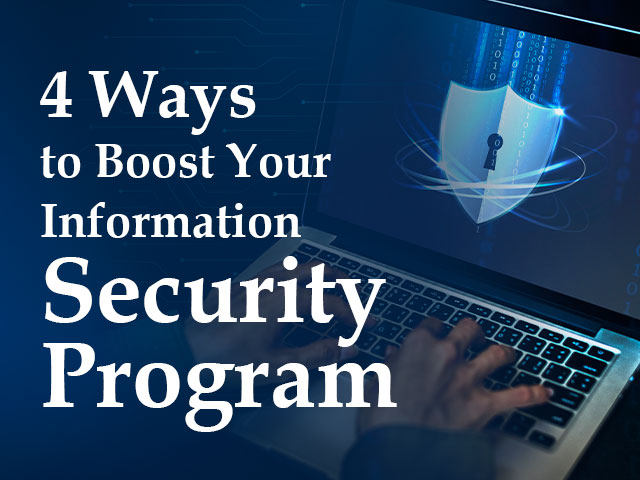4 Ways to Boost Your Information Security Program
Your organization has data to protect, and lots of it. All that information, from employees’ bank account numbers to the company’s intellectual property, is a potential goldmine for hackers. That means safeguarding it is a must. However, the ever-growing lists of successful data breaches and cyberattacks show the need for tighter security measures.
Robust prevention and defense plans aren’t limited to anti-malware and firewall apps, either. They also include risk management and compliance with government and industry standards. Solid data protection methods consider internal and external factors that can make an organization vulnerable to cybercrime. For tech leaders looking for ways to boost their information security programs, here are four of them.

1. Integrate Governance, Risk, and Compliance Tools
All companies must play by the rules and handle risks. However, the impacts of those rules and threats are becoming more challenging to understand and manage. A lack of tools that assess the effects of regulations and procedures from a company-wide perspective can compromise data security. So can a lack of transparency among employees.
It’s easy for staff and department managers to develop tunnel vision. They might not realize how something that works for them may put the entire company at risk. For instance, employees may find it more convenient to install whatever software they’d like on their work computers.
They believe it’s a hassle to go through IT and ask for permission.
The problem is that not all software programs that appear to be legitimate actually are. In addition, some applications need firewall and other network access permissions that could create data security risks. Software approval procedures and admin privilege restrictions are there to guard against and mitigate these threats.
In the same way, governance, risk, and compliance strategies sync everything that impacts information security. Also known as GRC, these strategies break down data silos and improve transparency within organizations. A GRC tool can integrate internal procedures, vendor requests, and consumer privacy laws to ensure alignment. Employees at all levels will be more aware of how their actions can help protect the company’s resources.
2. Test All Systems and Networks
Security audits and network vulnerability tests are critical to understanding where you need to close existing loopholes. You might think you have solid guardrails in place, but that doesn’t mean they’ll continue to hold up. There might be a few software security patches that got overlooked. Or there isn’t enough redundancy built into the company’s network configurations.
Businesses can perform security audits using internal employees or external firms. Many do a combination of both to help eliminate biases or to meet industry certification standards. Sometimes cybersecurity audit criteria can differ between industry or international guidelines, depending on what regulations and data practices exist.
For example, the Association of Healthcare Internal Auditors recommends looking at 12 different areas. These include software security, crisis management, and threat and vulnerability management. Regular auditing identifies weak internal practices and security measures, in addition to recommendations for improvement.
Network tests or simulations do the same, showing exactly where and how hackers can break through the defenses. With the information that consistent audits and vulnerability testing uncover, leaders can take swift action. You can fix weaknesses and strengthen prevention methods so the next data breach doesn’t happen on your watch.
3. Take a Close Look at Vendor Practices
Many organizations rely on vendors for cloud-based software and managed IT services. While you might manage physical access to your devices and networks, there will be things you can’t control. These include a vendor’s offsite data security measures, the timing of software patch releases, and an application’s built-in permission levels.
But what you can do is evaluate a vendor’s information security programs and practices. Not just before you do business with them but as an ongoing part of your data protection procedures. In a 2021 survey, 91% of IT and cybersecurity leaders in the U.S. reported security incidents tied to external vendors. Unfortunately, 15% of those managers reported 20 or more incidents linked to third parties.
This doesn’t mean you shouldn’t form partnerships or will find it feasible to keep everything in-house. However, dedicating resources to managing vendor relationships will keep the lines of communication open and help identify potential risks. You can develop more thorough incident response plans if a vendor reports a ransomware exploit or a breach. By examining what vendors are doing to safeguard data, you’ll know whether you should take additional precautions or cut ties.
4. Examine Storage and Disposal Methods
It’s a fact that the information you store and the technology you use will age. That means, at some point, you’ll need to get rid of it. Data sitting on a server may become redundant or something you no longer use. And the laptops and devices the company deployed years ago will eventually need an upgrade.
In the rush to keep day-to-day operations running, it’s easy to forget that old data and devices are vulnerabilities. Lax storage and disposal methods can become opportunities for data theft. Even if you no longer use information, it could be both sensitive and unprotected.
For example, you could have former employees’ Social Security numbers and addresses in an outdated database program. The app is so old that the developer no longer supports it, including no release of security updates. Plus, that program is on older server equipment that no one’s touched in months or years. It’s a breach waiting to happen, but implementing proper device and data disposal procedures can prevent it.
Keeping Data Safe
It’s not enough to have an information security program in place. As threats and regulations evolve, leaders must constantly assess and improve their plan’s guardrails. Failure to do so puts sensitive information, stakeholder confidence, and business sustainability at risk. Looking at your data security program as a system can lead you to better tools and procedures to strengthen it.





